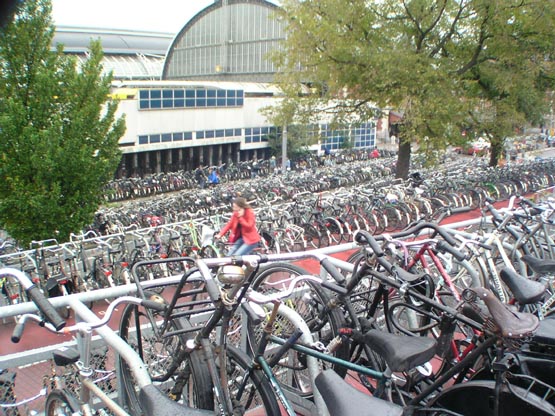Nothing infuriates me more than riding a bike in Edinburgh. This is because I compare it to when I lived in Holland for eleven years, where riding a bike is almost the normal mode of transport and children are almost born in the saddle. Forty-four years ago, when I lived in Amsterdam, believe it or not there were not only segregated bicycle lines and special traffic lights for cyclists, but the latter were set to give priority to cyclists. And woe betides anyone there who cut up a cyclist in the streets! Instead, here in backward, provincial Edinburgh, where riding a bike must rank as one of the most suicidal activities it is possible to undertake, attitudes towards cyclists are positively Neanderthal, and where to ride a bike is to be seen at best as some sort activity to be smiled at, or at worst, an activity in which only losers indulge in. This is despite the fact that cycling cuts down pollution, reduces traffic jams and is undoubtedly good for the health, and the government — though they continue to refuse to invest in cycle lanes — have been encouraging people to swop their cars for bikes for over ten years.
Yet, as our cities reach gridlock, and climate change accelerates due to carbon monoxide emissions, people continue to treat cyclists as if they’re some of abnormal aberration. What can the reason for this be? It is not as if the British don’t go abroad on holiday to the continent, where they can’t fail to notice that everywhere in Holland, Germany and Nordic countries such as Denmark and Sweden, there are thousands upon thousands of bikes thronging every station; indeed, last time I was in Berlin, I saw that they were even building a double storey park for bikes!
Nor is it only students there who ride bikes on the continent, it is lawyers, teachers. In Denmark, even the Prime Minister rides a bike. But ask anyone in Britain why they don’t follow suit, the reply is ‘Oh, it’s too hilly here’, or ‘the streets weren’t built for it’, etc. But where are the hills in Manchester, Birmingham, Liverpool, Leeds and practically every British city? Nor did I know that the towns of Gottingen, Copenhagen, Stockholm, Helsinki and Munster etc were build for bikes. No, the answer unfortunately lies elsewhere. First, it is down to that perennially British problem — lack of environmental awareness in particular and lack of education in general. Because the less educated you are, the less likely you are to ride a bike and to ride a bike here is to be seen as some sort of middle-class wanker clogging up the roads. The undeniable fact is that it is working-class White Van Men who shout at you and cut you up.
But there are other reasons. Perhaps the most important of these is the sad British preoccupation with everything from America, where the car reigns supreme of course, and to ride a bike is, if anything, seen as a greater sign of insanity than in Britain. Indeed, try riding a bike in Los Angeles or almost any other city and you may be arrested. It is no accident that Britain, as in so many others areas (such as, on the railways, going for oil in the Fifties instead of electricity, unlike practically every other country in Western Europe), slavishly followed America, as if so many other fields, in adopting the car culture lock stock and barrel.
The extent to which life is made difficult for cyclists in Edinburgh is astonishing. First, there are the cobbles in the New Town, which haven’t been maintained for decades, with the result that if you’re not careful and you get your wheel stuck in the huge gaps between them, you’re likely to find yourself lying in the gutter. Then there the people who, if you leave your bike chained to their railings, leave rude irate notes pinned to your bike saying that you are upsetting the local residents and that if you continue to leave your bike there it will be junked.

